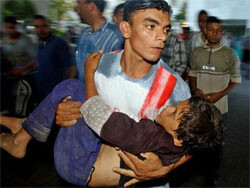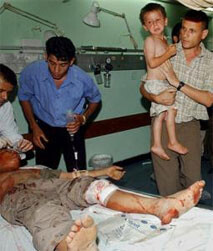The Electronic Intifada 10 June 2003

Original AP Caption: A wounded boy is carried into the Shifa hospital in Gaza City Tuesday, June 10, 2003. According to witnesses, Israeli troops fired from tanks and helicopters toward a Palestinian residential area in the northern Gaza Strip, between the town of Beit Hanoun and the Jabaliya refugee camp. Three Palestinians in their teens were killed and 30 people were wounded, doctors said. (AP Photo/Hatem Moussa)
Yet The Guardian’s Conal Urquhart reported that “As George Bush talked about peace with the Israeli and Palestinian prime ministers, Israeli soldiers were raiding the refugee camp of Balata and the city of Nablus for the third day running.” (“Children shot in third day of Israeli army raids, The Guardian, 5 June 2003)
Urquhart described how “screams echoed around the clinic” in the camp, “as a woman brought her seven-year-old daughter in for treatment. She had been shot in the abdomen by an Israeli soldier” as the Aqaba summit took place. Later the same day, the report said, a boy was shot in the head with a rubber-coated bullet.
According to the Red Crescent, The Guardian reported, “some 50 people have been treated for bullet and shrapnel wounds” in two days.
Dr. Samir Abu Zarzur, the head of the casualty department at Rafiah hospital in Nablus, said that his department treated 32 people injured by the Israeli army on Tuesday, the day President Bush was meeting the Palestinians’ Mahmoud Abbas and other Arab leaders in Sharm Al-Sheikh and urging them to join a struggle against “terrorism.”
“Twelve of the injured were children. One eight-year-old was shot in the face with a rubber-coated bullet. A young woman lost her eye and a young man lost a kidney. There are two or three still in a serious condition,” The Guardian quoted Abu Zarzur saying.
In a 7 June press release, the Palestinian Red Crescent Society (PCRS) reported that on 4 June, the day of the Aqaba summit, “A PRCS ambulance on its way to rescue injured people in the Balata Camp was stopped by Israeli soldiers. Soldiers attacked the ambulance, hitting one of the EMTs on the face and head.” Under threats of further violence from the soldiers, the ambulance was forced to turn back.
The only US newspaper that we were able to find that reported the events in Balata was Newsday, on 5 June, in a report by the same Conal Urquhart.
The Chicago Tribune’s account of the day of the Aqaba meeting was quite different. The paper said, “the day gave rise to hope not only for what happened but also for what did not: There was no major Israeli-Palestinian violence” (“Bush hails good beginning, Chicago Tribune, 5 June 2003). The report made no mention of the three-day long Israeli attack on Balata Camp that caused so many injuries and continued during the Aqaba summit.
Nor did the violence and suffering stop after the summit.
On 5 June, 15 year-old Ibrahim Abu Habla, who had been shot in the eye by Israeli occupation forces in Tulkarm, also near Nablus, on 28 May, died of his wounds, Agence France Presse reported. He had been among a number of children shot with live bullets for throwing stones at the occupier’s tanks. (“Palestinian dies of wounds in West Bank,” AFP, 5 June, 2003)
And just hours after the Aqaba summit, Israeli occupation forces attacked in Gaza’s Rafah, close to the Egyptian border. Agence France Presse reported that Israeli tanks, accompanied by armored bulldozers entered part of the town and “demolished four houses before leaving.” (“Israeli incursion into Gaza Strip, AFP, 5 June 2003).
The same day, in the central Gaza Strip town of Deir al Balah, the occupation forces expelled the residents of a two-story building from their homes and destroyed the building. Agence France Presse quoted Palestinian medics saying that the building’s owner Ahmed Tawashi, “was moderately injured by gunfire when the Israeli soldiers forced him and his family to leave the house,” and that the residents were not allowed to take any of their furniture or personal belongings. (“Israeli army demolish Palestinian house in Gaza Strip, AFP, 5 June 2003)
The next day, Israeli occupation forces carried out an ambush on a Palestinian house near Tulkarm, killing two men Israel claimed were Hamas militants planning to become suicide bombers, and wounding a third. This death squad action, and the Israeli violence that preceded it failed to excite the attention of the US press, which remained decidedly focused on the upbeat message coming from Aqaba.
Yet, when Palestinian fighters attacked Israeli occupation forces in the West Bank and Gaza Strip on Sunday, 8 June, killing five Israeli soldiers and losing five combatants themselves, many US media organizations suddenly took notice.
The Los Angeles Times reported that these attacks were “the first since last week’s summit” in Aqaba, and made no mention of any of the preceding Israeli attacks on Palestinians (“Sharon vows to stay course despite raids,” Los Angeles Times, 9 June 2003).
The New York Times claimed that the 8 June attacks “brought the first major violence here since the new Palestinian prime minister met in Jordan last week with Prime Minister Ariel Sharon” (“Abbas answers critics, vows support for Palestinian issues,” New York Times, 9 June 2003).
NBC News anchor Don Teague told viewers on Sunday morning that the attack on the Israeli soldiers in Gaza was “the first deadly attack since last week’s Mideast summit.” The CBS Evening news reported that five Israelis were killed, but failed to mention that all were armed, combatant occupation soldiers.
On 9-10 June, the US media paid a great deal of attention to Israel’s removal of “illegal” settler “outposts” in the Occupied Territories. The New York Times carried a lengthy front-page report on the Israeli actions which amounted to little more than the removal of a few empty trailers, a water tank and a guard post. The Times report was the only one we found that mentioned — albeit in a single sentence and with little detail — that just before their much advertised action against the outposts, Israeli forces blew up thirteen houses in the town of Beit Hanoun in the northern Gaza Strip, making dozens of Palestinians homeless. (“In Israeli gesture, tower is removed near settlement,” New York Times, 10 June 2003).
On 10 June, Christian Peacemaker Teams reported that Israeli occupation forces in Hebron forcibly ended a peaceful six-day effort by students to reopen their university that Israel had shut five months ago. Students sawed open the welded gate and tried to re-enter their campus. Occupation soldiers forced them away and fired percussion grenades and re-welded the gates. This is one example of the countless instances of non-violent civil disobedience by Palestinians called for frequently by US commentators, but just as frequently ignored in coverage when they occur (“Israeli army welds gate shut at Hebron University, Christian Peacemaker Teams, 10 June 2003).
Previous EI coverage trends have documented that US press reports routinely ignore or downplay Israeli violence against Palestinians, even though the ratio of unarmed Palestinian to Israeli civilians killed in the conflict is more than three to one since September 2000. Periods in which dozens of Palestinians have been killed have been widely and routinely termed “periods of calm,” or “relative calm” just because few or no Israelis were killed during the same time. Such inaccurate reporting reinforces the claims of Israel’s apologists that violence is a Palestinian problem to which Israel is only reacting, and helps to conceal the enormous amount of violence Israel uses to maintain its military occupation of more than three million Palestinians and their land.

Original AP Caption: A Palestinian boy, center, cries as he waits to be treated while doctors work on other wounded children at the Shifa hospital in Gaza city Tuesday June 10, 2003 following Israeli troops attack of a Palestinian residential area in the northern Gaza Strip, between the town of Beit Hanoun and the Jabaliya refugee camp. Three Palestinians in their teens were killed and 30 people were wounded, doctors said. (AP Photo/Hatem Moussa)
On 10 June, Israel’s efforts to derail the road map intensified with an attempt to murder Hamas spokesman Abdul ‘Aziz al Rantisi, which left him and his son injured, and a woman bystander dead. Later the same day, Ha’aretz reported that Israeli tanks and helicopter gunships fired toward “a Palestinian residential area in the northern Gaza Strip on Tuesday, killing three Palestinians and wounding 30.” The three dead were identified as a 16-year-old girl and two 19-year-old men, who lived between Beit Hanoun and Jabaliya refugee camp.
Early coverage of these events indicated that as usual, Palestinians will be unjustly blamed for ‘reigniting’ a cycle of violence that in reality never paused for a single day.
Michael F. Brown contributed to this report.





